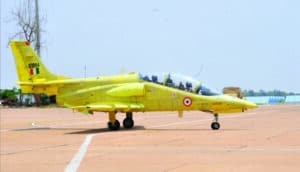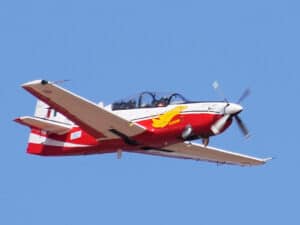Aerospace
Another milestone for two more Indian aircraft IJT & HTT 40

India has reached another milestone in the development of indigenous aircraft, as the HTT-40 earned its airworthiness clearance certificate from the Centre for Military Airworthiness and Certification on June 6th. It is a basic turboprop trainer plane.
According to a HAL source, the production contract will be inked in October or November 2022. HAL has the potential to construct 24 aircraft per year at its plants in Nasik and Bangalore, and production may begin 18 months after the day of contract signature).
The HTT-40 is a tandem seat aircraft made entirely of metal and propelled by a 1,100 horsepower turboprop engine.
The HAL HTT-40 basic turboprop trainer has been certified by India. This paves the path for the aircraft to be inducted into the Indian Air Force in the future.
This aircraft has a gross weight of 2,800 kg, can carry up to 450 kg of fuel, and is powered by a single 834 kilo watt Honeywell turboprop engine.
The aircraft has a maximum speed of 400 km/h, a range of 1,000 km, and a ceiling height of 19,680 feet. This aircraft, too, can be armed with a gun, rockets, and bombs. As a basic trainer, it will replace the Indian Air Force’s retired HPT-32 Deepak.
The IAF issued a request for proposal to HAL in 2021 for 70 HTT40s with an option for 38 more. Production will take place in the manufacturing units in Bangalore and Nashik.
Another achievement by HAL is the successful demonstration of spins in IJT aircraft.
HAL’s Intermediate Jet Trainer, conceived and developed for stage II IAF pilot training, has successfully demonstrated the capacity to perform six turn spins to the LH and RH sides. The IJT, which was planned by HAL as a replacement for the IAF fleet’s ageing Kirans, had completed demonstration of its capabilities in terms of altitude and speed envelope, load factor, satisfactory stall characteristics, and limited weapons capability far sooner than required by the IAF.
The IJT, which was planned by HAL as a replacement for the IAF fleet’s ageing Kirans, had completed demonstration of its capabilities in terms of altitude and speed envelope, load factor, satisfactory stall characteristics, and limited weapons capability far sooner than required by the IAF. HAL will soon have cutting-edge trainers for IAF pilot stage I and II training.
Tell us what you think of both aircraft’s main accomplishments in the comments area.

Aerospace
Boeing Transfers Rocket Stage to NASA, Paving Way for Human Moon Mission

Boeing has achieved a significant milestone by providing NASA with the second core stage of the Space Launch System (SLS) rocket.
This crucial component, crafted at NASA’s Michoud Assembly Facility (MAF), is set to propel the Artemis II crew into lunar orbit, marking humanity’s return to deep space after a 50-year hiatus.
The monumental Boeing-built rocket stage, the largest element of the Artemis II mission, will embark on a journey aboard the Pegasus barge, traveling 900 miles to NASA’s Kennedy Space Center.
Comparison of two legendary aircraft B777x vs B747 aircraft:Click here
Upon arrival, it will be meticulously integrated with other essential Artemis II components, including the upper stage, solid rocket boosters, and NASA’s Orion spacecraft within the iconic Vehicle Assembly Building. This intricate integration process is a vital step toward the eagerly anticipated Artemis II launch, slated for 2025.
“Boeing-built products helped land humankind on the moon in 1969, and we’re proud to continue that legacy through the Artemis generation,” remarked Dave Dutcher, vice president and program manager for Boeing’s SLS program. “Together, with NASA and our industry partners and suppliers, we are building the world’s most capable rocket and paving the way to deep space through America’s rocket factory in New Orleans.”
NASA, Lockheed Martin Reveal X-59 Quiet Supersonic Aircraft:Click here
The delivery of Core Stage 2 marks a significant achievement in the evolution of the SLS rocket. Towering over 200 feet and powered by four RS-25 engines, this core stage, coupled with two solid-fueled booster rockets, will generate a staggering 8.8 million pounds of thrust. This immense power is crucial to launching Artemis II and future missions into the vast expanse of space.
The SLS rocket stands unparalleled in its capability to transport both crew and substantial cargo to the moon and beyond in a single launch. Its extraordinary capacity will facilitate the delivery of human-rated spacecraft, habitats, and scientific missions to destinations including the moon and Mars, ushering in a new era of space exploration.
-

 Travel1 week ago
Travel1 week agoAir India to Expand US Operations with Three New Routes After a Decade
-

 Travel2 weeks ago
Travel2 weeks agoWhy We Should Avoid These Stamps in a Passport
-

 Airlines1 month ago
Airlines1 month agoInvestigations Reveal Fake Chinese Titanium in Boeing and Airbus Jets
-

 Tech4 weeks ago
Tech4 weeks agoChina’s CATL Plans 1,800-Mile Electric Plane Launch by 2027
-

 Airport3 days ago
Airport3 days agoTop 10 Largest Airports in the World by Size
-

 Aerospace4 weeks ago
Aerospace4 weeks agoChina’s Fighter Jets Turn Wings into Autonomous Drones
-

 Airlines4 days ago
Airlines4 days agoAir India Rolls Out A350s for Delhi-New York JFK and Newark Routes
-

 Defence3 weeks ago
Defence3 weeks agoBoeing Enhances Chinook with New Engines and Block II Upgrades at $96 Million









